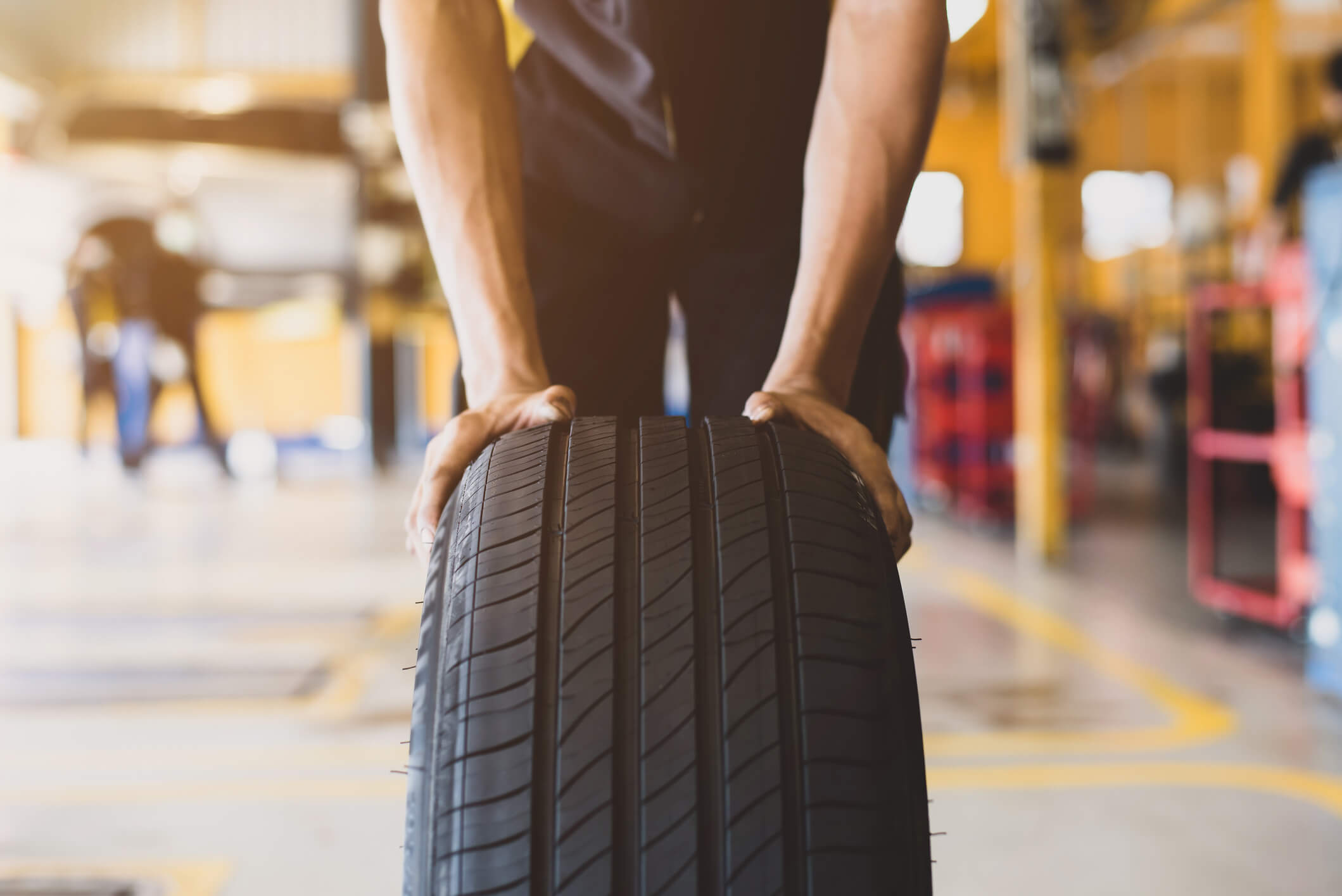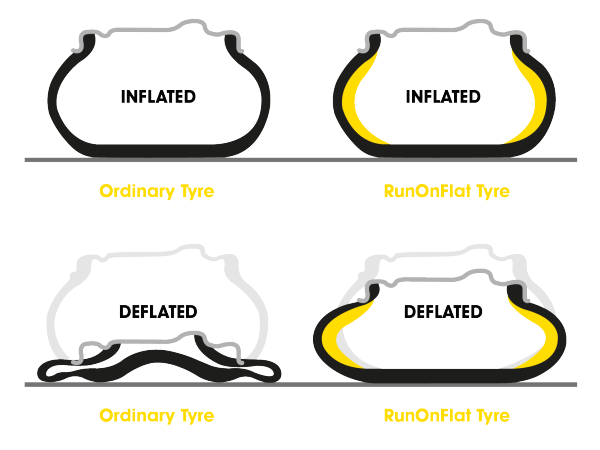Run-flat tires are getting more common, but many drivers still don’t understand what they are and how they work. Do they drive the same as regular tires? Can you install them on your car? In this article, we’ll answer these questions and help you determine if you should get run-flat tires.

What are Run-Flat Tires?
A run-flat tire is designed to be safe to use even after it suffers a puncture. That means if your tire gets punctured, you won’t need to stop by the side of the road, which can lead to a risky situation. Instead, run-flat tires have just enough sturdiness to get you to a workshop and get it changed.
How Do Run-Flat Tires Work?
Run-flat tires have thicker, stiffer, reinforced sidewalls with multiple layers of rubber and heat-resistant cord. When a regular tire gets punctured, it deflates and loses its shape. As a result, it doesn’t provide enough cushioning between the road and wheel. If you continue to drive with a flat tire, the rubber can break off and totally expose the metal of the wheel which can cause even more damage to your car.
When a run-flat tire gets punctured and loses air, it doesn’t deflate like a regular tire. Instead, the reinforced sidewalls of the tire provide structural support and help it keep its shape so you can keep driving. While most cars do not come with run-flat tires by default, more modern cars, especially luxury brands come with them installed. Since you’ll barely notice any deflation on a run-flat tire, vehicles fitted with these tires from the factory usually have a tire pressure monitoring system (TPMS) that detects air pressure loss and alerts the driver about it.
Read More: A Guide to Car Warning Lights

Image Source: Dunlop
How to Identify Run-Flat Tires
Modern cars that come with run-flat tires don’t have a spare tire in the boot. So if you notice that you don’t have a spare tire, your car could have run-flats. BMW and Lexus are manufacturers that most commonly fit run-flat tires across their range
You can also identify a run-flat tire based on the code written on the tire sidewall. However, since there is no standard code for this type of tire, it can vary between manufacturers. Below are some of the codes found on run-flat tires.
| Brand | Run Flat Tire Code |
| Bridgestone | RFT (Run-Flat Tire) |
| Dunlop | DSST (Dunlop Self Supporting Tire) |
| Continental | SSR (Self Supporting Run Flat) |
| Michelin | ZP |
| Goodyear | EMT (Extended Mobility Tire) |
| Pirelli | RSC (Run-flat System Component) or just printed ‘Run Flat’ |
| Yokohama | RF (Run Flat) |
Price of Run Flat-Tires in Malaysia
Run-flat tires are more expensive than regular tires. Like regular tires, they vary in price depending on their brand, size, and other factors. Also, they generally come in sizes of 17-inches and above which means they are designed for luxury and larger cars. The price of run-flat tires in Malaysia can range from RM700 to over RM1500 per tire. However, you may be able to find cheaper options when you buy older, unused tires. Tires that are two to three years old and have been stored properly indoors are generally fine to use and offer good value if you can get them at a discounted price.
How Long Do Run-Flat Tires Last?
Run-flat tires are made of the same materials and have a similar tread pattern or construction as conventional tires, so they should last as long as regular tires. That said, the lifespan of any tire can vary depending on your driving habits, climate, road condition, and how well you maintain your tires.
It’s recommended to replace your tires every six years, though you may need to replace it earlier if you have worn tire treads or damaged tires. To extend the lifespan of your tires, make sure to maintain the right pressure and rotate them once every six months or every 10,000 kilometers.

Run-Flat Tire Tips
Although run-flat tires last as long as regular tires and require the same amount of care, there are some things you should know when using them.
Driving on Run-Flat Tires
The main purpose of run-flat tires is to allow you to drive safely to a location where you can replace your tires in the event they get punctured. This prevents you from having to stop your car on the road and replace your tires in a risky environment. That said, punctured run-flat tires have limited mileage and have to be replaced immediately.
Once punctured, you have to reduce your driving speed. Check your tire manufacturer’s specification for the maximum speed and distance you should be able to drive on. Most run-flats can run for a maximum speed of 80 km/h for up to 80 kilometers. You shouldn’t repair a run-flat tire as its structural strength may have been compromised after a puncture. However, you can temporarily patch up small punctures like how you would on regular tires.
Can You Fit Run-Flat Tires on Older Vehicles?
While you can install run-flat tires on older vehicles, you may need to make some changes to your vehicle’s suspension. Since these tires are stiffer, they can contribute to a stiffer ride. Since you probably won’t notice a puncture when you drive on run-flat tires, you should install a TPMS to alert you in case of a puncture. This will let you know that you need to drive within the limits of your punctured tire and get it replaced immediately.
Can You Replace Run-Flat Tires with Regular Tires?
On a vehicle fitted with original equipment (OE) run-flat tires, the manufacturer has adjusted the suspension to suit the tires. Therefore, it’s often not recommended to install regular tires on vehicles designed to use run-flats. That said, it is indeed possible. If you do choose to replace your run-flats with regular tires, be sure to choose tires with the correct size, speed rating, and load index. You should also replace all four tires and not mix run-flats with regular tires. Also, don’t forget to carry a spare tire and tire changing kit in your vehicle.
Read More: Car Care and Driving Tips for The Rainy Season
Pros and Cons of Run-Flat Tires
Run-flat tires can be extremely helpful in case your tire gets punctured on the road. However, they may not be for everyone. Here are the pros and cons of using run-flat tires.
Pros:
- Allows you to drive on a flat tire: You don’t have to stop at the side of the road or get out in the rain to change a punctured tire.
- Has better stability after a blowout: Unlike a regular tire, a run-flat tire can maintain its shape following a blowout and still support the weight of your car. This gives you near-normal steering and handling so you can get to a nearby workshop.
- Lowers vehicle weight: Since there’s no need to carry a spare tire and tools, the overall weight of the vehicle is reduced. You’ll also have more space in the boot.
Cons:
- Higher costs: Run-flat tires tend to cost more than regular ones, averaging around 25 percent more.
- No spare tire: While you can drive your car to a nearby workshop to get its tires changed in case of a puncture, it can be a problem if you ever need a spare tire.
- Harsher ride quality: The stiffer sidewalls on these tires result in a harsher ride. That said, cars that come with run-flat tires from the factory are tuned by the manufacturer to offset the harsh ride.
- Less choice available: Run-flat tires aren’t as widely used as regular tires so they are not as widely available. They also tend to come in larger sizes. While you shouldn’t have problems finding the tire you need in the city, you might need to pre-order them a few days ahead if you’re in a small town.
- Hard to diagnose a puncture: It’s hard to tell if your tires are low on air when you have run-flats. That’s why it’s important to have a working TPMS on board and check your tire pressure frequently.
Run-flat tires are great on the off-chance that you encounter a flat tire while on the road. That said, whichever type of tires your car is fitted with, remember to keep your tires properly maintained and they’ll serve you well.
If you’re looking for a pre-owned car with excellent value, check out CARSOME. Our CARSOME Certified cars have gone through a 175-point inspection and professional refurbishment to ensure that every part of the car, including the tires, is in good condition. During the refurbishment process, we ensure that the tires on our cars have a minimum tread depth of 2.2 millimeters, or we’ll switch them out. This surpasses global safety standards by 25%.
Each CARSOME Certified car even comes with a five-day money-back guarantee and a one-year warranty for your peace of mind.
